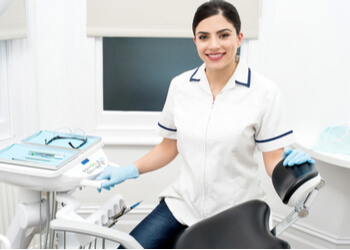Sterilising Dental Instruments
An instrument is considered to be sterilised when the chain of possible microbial cross-contamination between patients is broken by inspecting, cleaning, and sterilising using saturated steam as the one produced in the MELAG Autoclave. Once the instruments are sterilised, they are considered sterile when they are wrapped in a protective package and stored in a clean environment before they are handed to the dentist for the next use.
A steam steriliser like the MELAG Autoclave is the most effective method of dental instrument sterilisation. The increased temperatures in the autoclave combined with the regulated holding time that provides time for the thorough drying of the instruments ensure success with the sterilisation process. However, before the use of the MELAG Autoclave can fulfil its role in the sterilisation process, certain steps need to be taken by the dentist and trained staff to establish practices and procedures that assure a sterile instrument.
Designate a Cleaning Area
The first step in dental instrument sterilisation is to take the used instruments to a location that has been created for the sole purpose of cleaning and sterilising the instruments. This location should have a “dirty” area and a corresponding “clean” area to establish a smooth flow of the instruments along an uninterrupted path to being sterilised.
The person in charge of the process should make sure that they use surgical gloves, as well as padded medical gloves, for sanitation and protection. There is always the chance of the skin being pierced by infected dental instruments, so using gloves is an important part of practising universal precautions.
Clean the Instruments
Cleaning the instruments involves rinsing them under running water to remove any particles or saliva that may have accumulated after use.
After rinsing the instruments, they should be placed in a cassette, which is a plastic tray that has holes for drainage. The cassette is placed in a large tube with water called an ultrasonic.
This procedure removes even more debris and particles from the instruments in about 10 minutes. The ultrasonic has a timer, and this time limit should be adhered to. Leaving the instruments in for too long may cause them to corrode.

Prepare the Instruments for the MELAG Autoclave
After another rinsing under running water, the instruments should be placed on a clean towel in the “clean” area to dry. Successful dental instrument sterilisation needs to have only dry instruments placed in the MELAG Autoclave. The steam under pressure and the possibility of moisture can also add to rust or corrosion if the instruments are not thoroughly dried.
Once dry, the instruments are placed in a sterile package and labelled. If a group of instruments are used together for a regular procedure, they can be packaged together. The practitioner should be sure there are no holes in the packages due to an instrument piercing the plastic.
If this happens, a second package should be used and the former one discarded. This package should be initialled by the person who prepared it, and it should be dated. This step is important to ensure the quality of the sterilisation and to provide a mechanism to use the instruments on a consistent rotating basis.
Sanitising the Instruments
When the packaging is complete, and the packages have again been checked for any holes, they can be placed in the MELAG Autoclave for the sanitising cycle. This procedure is done in the clean area of the sanitising location. Once the autoclave finishes cleaning with pressurised steam under high temperature and removing all the moisture through special drying applications, the dental instruments are considered to be sterilised. They are then placed in a clean cabinet for use on a rotating basis as per the date on the package.
Final Step
The MELAG Autoclave has the capability of printing a paper record of the results of the sanitising, along with the time the dental instruments were taken through the different phases of the process programmed into the machine. This documentation is critical to ensure that the machine is working correctly. Air and water brought into the machine for the sanitising process have to be monitored at all times for purity, and these printed records can add to that evaluation.
Final Thoughts
The procedure for dental instrument sanitisation depends on the steam cleaning provided by the MELAG Autoclave. However, for the autoclave to be effective, the dental practice needs to have a trained staff dedicated to the smooth implementation of pre-cleaning and drying of the dental instruments.
This procedure and its consistent practice make the sanitisation part of the operation of a professional dentist’s surgery by eliminating the fear of contamination from shared disease-causing bacteria. MELAG Autoclave models are manufactured and designed to meet your dental office needs no matter how big or small your practice.
Contact us today at (02) 8880 7813 and let us help you find the right autoclave model for your practice.


